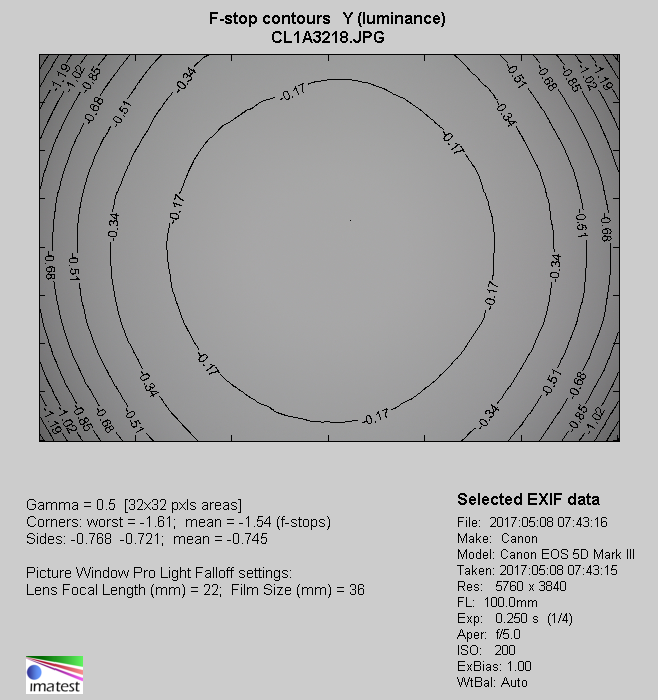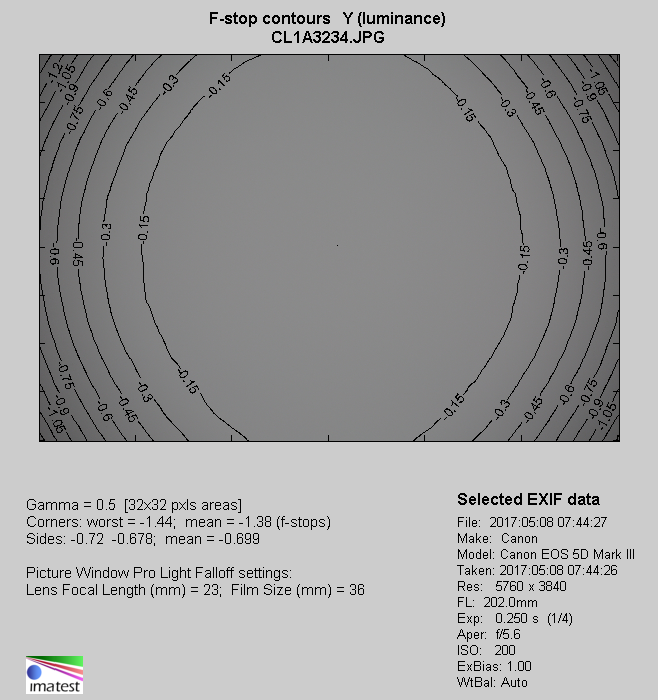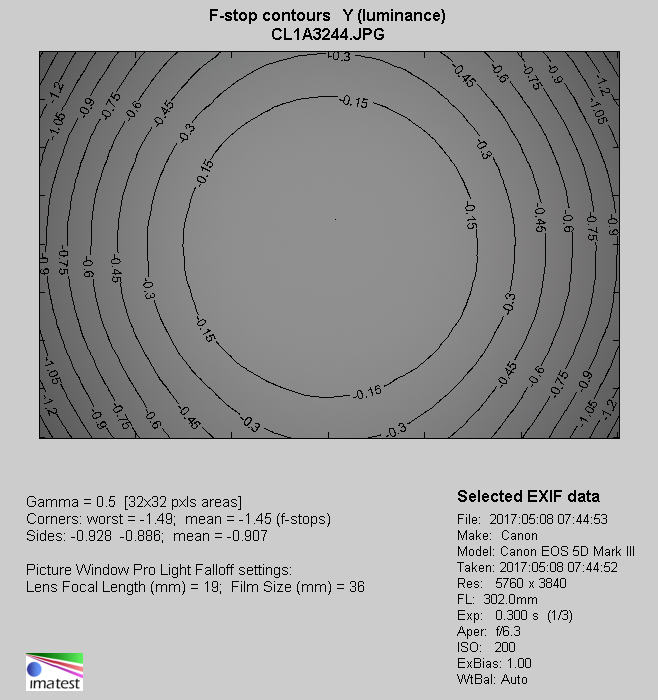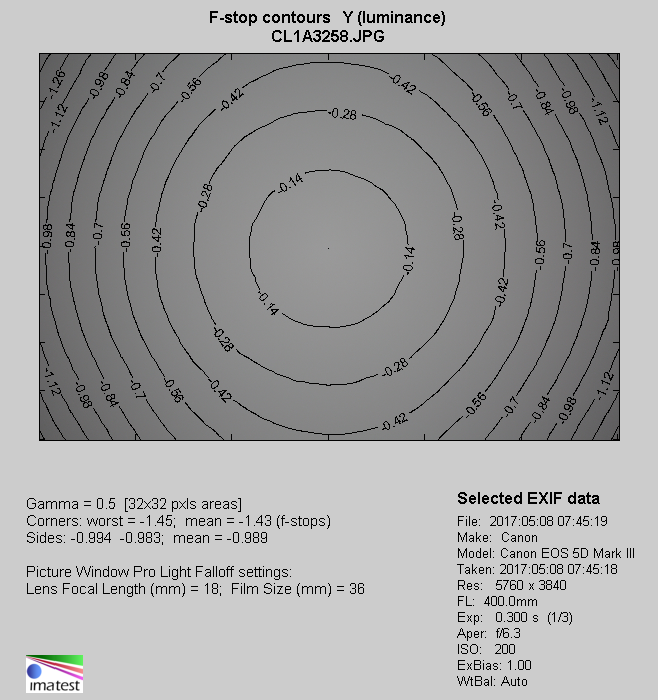Sigma C 100-400 mm f/5-6.3 DG OS HSM
8. Vignetting
| Canon 50D, 100 mm, f/5.0 | Canon 50D, 100 mm, f/5.6 |

|

|
| Canon 50D, 200 mm, f/5.6 | Canon 50D, 200 mm, f/8.0 |

|

|
| Canon 50D, 300 mm, f/6.3 | Canon 50D, 300 mm, f/8.0 |

|

|
| Canon 50D, 400 mm, f/6.3 | Canon 50D, 400 mm, f/8.0 |

|

|
Please Support UsIf you enjoy our reviews and articles, and you want us to continue our work please, support our website by donating through PayPal. The funds are going to be used for paying our editorial team, renting servers, and equipping our testing studio; only that way we will be able to continue providing you interesting content for free. |
- - - - - - - - - - - - - - - - - - - - - - - - - - - - - - - - - - - - - - - - - - - - - - - -
It’s clear that the smaller APS-C sensor can’t cause any problems for the tested lens and our measurements confirm that. At the shortest focal length it would be difficult to see any vignetting at all, even at the maximum relative aperture, as it amounts to 13% (−0.42 EV). On stopping down the lens to f/5.6 you see that aberration decrease to an imperceptible level of 8% (−0.23 EV).
An even better situation you observe at 200 mm where, by f/5.6 and f/8.0, the vignetting is, respectively, 10% (−0.31 EV) and 6% (−0.18 EV).
At longer focal lengths there is a slight increase of the aberration, described in this chapter. At 300 mm and by f/6.3 the vignetting reaches 17% (−0.54 EV), and, on stopping down the aperture to f/8.0 it decreases to 8% (−0.26 EV). At 400 mm and by f/6.3 the brightness loss in the frame corners amounts to 21% (−0.69 EV) and by f/8.0 it decreases to a value of 11% (−0.35 EV).
Now let’s check the situation for full frame of the Canon EOS 5D Mark III.
| Canon 5D III, 100 mm, f/5.0 | Canon 5D III, 100 mm, f/5.6 |

|

|
| Canon 5D III, 200 mm, f/5.6 | Canon 5D III, 200 mm, f/8.0 |

|

|
| Canon 5D III, 300 mm, f/6.3 | Canon 5D III, 300 mm, f/8.0 |

|

|
| Canon 5D III, 400 mm, f/6.3 | Canon 5D III, 400 mm, f/8.0 |

|

|
If you employ the 100 mm focal length and the maximum relative aperture you have to take into account the loss of brightness amounting to 41% (−1.54 EV). It’s a lot. On stopping down the aperture to f/5.6 that value decreases to 32% (−1.10 EV). The problem disappears by f/8.0 and f/11.0, where it is, respectively, 14% (−0.43 EV) and 7% (−0.20 EV).
At 200 mm focal length you notice a slight decrease of vignetting compared to the shortest focal length. By f/5.6 that aberration drops to 38% (−1.38 EV), by f/8.0 it reaches 23% (−0.52 EV), and by f/11.0 it decreases to 16% (−0.52 EV). Only by f/16 you can see a practically complete disappearance of any vignetting as its official value amounts to just 10% (−0.30 EV).
A similar situation can be noticed at the longest focal lengths. At 300 mm and by f/6.3 the vignetting reaches 39% (−1.45 EV), by f/8.0 it is 25% (−0.83 EV) and by f/11.0 it decreases to 17% (−0.55 EV). By f/16.0 it drops further to 10% (−0.29 EV).
At 400 mm and by the maximum relative aperture the light fall-off in the frame corners reaches 39% (−1.43 EV). By f/8.0, f/11.0 and f/16.0 apertures we got respectively 23% (−0.75 EV), 15% (−0.47 EV) and 7% (−0.21 EV).
In this category you get a predictable performance. The slower and smaller Sigma had to lose when compared to its brand name rivals. Let’s just remind that the worst result of the Nikkor AF-S 80–400 mm VR amounted to 31%, and the Canon’s 100–400 mm II most distinct brightness loss was 39%. In both cases we got those values at the maximum focal length, the results near the shorter end ranged from 20% to 30%.
| Canon 5D Mk III, 100 mm, f/5.0 |
 |
| Canon 5D Mk III, 200 mm, f/5.6 |
 |
| Canon 5D Mk III, 300 mm, f/6.3 |
 |
| Canon 5D Mk III, 400 mm, f/6.3 |
 |






